Factual error: When the map of the German advance is shown, Switzerland is shown to be taken over. Switzerland was never invaded by the Germans. (00:05:10)
Revealing mistake: Midway through the movie, there is a long-shot of several characters walking outside between two gutted factory buildings. The camera pulls back, zeros in on the base of a huge chimney and pans upward to the very top - where two men in black and white checkerboard jackets are working.
Factual error: When Kruschev and Vasy go to the press meeting the Soviet National Anthem is playing in the background. The actual anthem was not written until January of 1944, a year after the Battle of Stalingrad. In addition, the song sung is the 1977 lyrics. The lyrics used in 1944 were slightly different. See http://www.skazka.no/anthems/ for more info.
Factual error: The film map depicting the German advance showed Germany invading Turkey. Turkey did not enter the war until 1945 and never engaged in any combat. (00:05:05)
Suggested correction: It does not show the German advancement in true historical order, but more like a red shadow that expands across Europe in a steady pace. And just as the camera starts zooming in on Stalingrad, you can see a small sliver of red starting to spread on the south-eastern coast of Norway.
It's not red but black. Norway was conquered by Germany, Turkey was an Allied country.
Factual error: The Junkers 88 bombers are flying far, far too low for a bombing run. They are barely clearing the buildings they are bombing. Low level bombing on an urban target would mean the bomber would be flying at between 600 and 700 feet whereas these bombers are flying at something like 30 or 40 feet above the rooftops of the buildings they are attacking. Even banking steeply would be a ridiculously dangerous manoeuvre, and at that height they would be sitting ducks for small arms fire and would be damaged by the explosions and debris from their own bombs. (00:40:15)
Suggested correction: The JU 88 was a diver bomber used for low level bombing for precision. Because of the lack of sufficient JU-87's (Stukas), the JU-88 was used for ground support. It was normal for them to fly that low, despite being more vulnerable to small arms fire.
That isn't "low level" bombing - it's suicide. Low level bombing on an urban target would mean the bomber would be flying at between 600 and 700 feet. These bombers are flying at something like 30 or 40 feet above the rooftops of the buildings they are attacking. Even banking steeply would be a ridiculously dangerous manoeuvre. The original posting is correct.
Low level bombing is most definitely not 600 feet. They could easily operate at altitude below 100 meters. I've seen footage of low level bombing at exactly the altitude of the planes in the movie (by B-25s). Planes that fly that low won't be using bombs that explode right under them, they would use whats called "retarded-fall" bombs that have increase air resistance so there is a delay of their fall and won't explode right under the plane. They may even fly lower in Stalingrad to avoid AA fire, which have a harder time targeting low flying aircraft. They might also be flying as low as possible to get visual confirmation of their targets, to avoid hitting friendlies.
Ju88s had a climb rate between 700-800 feet per minute. Given that the primary German airfield was less than 15mi away at Pitomnik, their maximum altitude for a less-than-3-minute flight was a meager 2340 feet (~700m). Lower altitudes are within the realm of reason. Due to the Soviet strategy of keeping their front lines as close to the Germans as possible, it's almost necessary to fly low and get as accurate bombing runs as possible.
Continuity mistake: In the scene taking place at the fountain, Danilov's rifle has a round receiver. When he hands the rifle over to Zaitsev, the rifle has a hex receiver. When Zaitsev hands the rifle back, the rifle has a round receiver again. (00:17:30)
Revealing mistake: When the character played by Joseph Fiennes is in the Soviet headquarters, you can see his glasses shine with a purplish light. This is because his glasses are anti-reflex, something that was not available until much later than WWII.
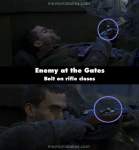
Continuity mistake: In the beginning, when the political officer is crouching behind the wall, the bolt on his rifle is open, but when he leans up to fire, the bolt is magically closed. (00:16:45)
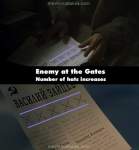
Continuity mistake: When Danilov first shows Vassili the leaflets that praise his exploits, the shot shows a leaflet coming off the printing press with four "x-ed out helmets", indicating how many German soldiers Vassili has killed. The camera follows the leaflet off the press, Danilov picks up the leaflet and hands it Vassili. The next shot shows Vassili looking at the leaflet, but now there are five x-ed out helmets. (00:20:30)
Suggested correction: The other X'd-out helmet is beneath Danilov's thumb. You'll notice that the border is wider and there is an additional text column on the left of the page beneath the helmet hidden by his thumb.
That other X under his thumb is from a 2nd printed leaflet. There's not an extra column of text or a 5th X. Plus, look how the first X lines up with the B, whereas what you think is the first X wouldn't be under the B.
Factual error: Headquarters do not have tanks park near them. I do not know why there is always what looked like a company of German Panzer IIIj's parked in front of the 6th Army HQ. (00:33:50)
Factual error: In one scene, a Soviet T-34 tank is shown in the middle of the battlefield. This is a T-34-85 model (as evidenced by its large three-man turret), which did not appear until late 1943. During Stalingrad, the Red Army was still using the older T-34 models which used a 76mm F-34 Tank Gun housed in a smaller two-man turret.
Factual error: Sasha reads a Russian newspaper account to König in which Vasily's new rifle is described as a "Mosin-Nagant." While this name is (and was) used in Western literature, it was not used to describe this rifle in Russia until long after the war; the gun was referred to simply as the Mosin rifle. (00:43:25)
Continuity mistake: At the beginning of the film when the Russian troops are rushing headlong at the Germans, there is an obvious cut in one shot as several people shift places and one Russian just disappears.
Factual error: The German army never had a 116 Infantry Division in WWII. There was a 116 Panzer Division that was formed in 1944 from the 16 Panzergrenadier Division.
Continuity mistake: When Vassili is behind the chemical factory waiting for the Major to appear, the soldiers run out from under the train cars. The next shot shows the soldiers from behind, and if you look closely a horrible editing mistake was made. Some of the soldiers suddenly disappear, and then reappear.
Revealing mistake: When Danilov and Kruschev are in the war room, when they think Zaitsev is dead, pay attention to the maps on the walls. These are modern US and British defence maps that weren't available until starting about 1960. The clue is the the numbers on the squares. These are flight altitudes clearances for jets. Also, you can see that the maps are in Roman letters. Soviet maps during WWII were in Cyrillic and they looked differently.
Continuity mistake: During the scene where Vassili is hiding from Major König behind an old oven and trying to get his gun back by tossing his pocket knife at it and pulling the string, König shoots the string. The string breaks, but the bullet doesn't hit anything behind the string, as if it was stopped by the string!
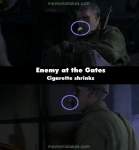
Continuity mistake: Before they attempt to trap König with the raised helmet trick, we see one of them light a cigarette. It initially appears to be very large and misshapen. When the angle changes, the cigarette has shrunk to more than half its previous size and is perfectly rolled.
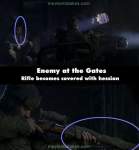
Continuity mistake: When Vassili and his two friends go out to trap König by shooting telephone repairmen, their rifles are covered by hessian, when they are shooting the repairman the guns are uncovered, and when Koulikov and Vassili are on the way back and jump across the gap in the buildings their rifles are covered again.
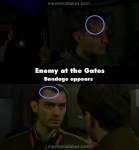
Continuity mistake: When Jude Law and Joseph Fiennes are walking through the Soviet Headquarters and talking about how the sniper never relocates, in the first scenes, Jude Law has no bandage on his wound on his head, however in the later close up shot there is a bandage, this within a few minutes. There definitely is no bandage present in the first scenes. (00:45:20)
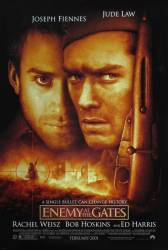





Suggested correction: It doesn't show German advances. It shows the German influence over Europe, symbolizing it covers all of Europe and then expanded towards the East. Italy was never conquered by the Germans either yet it was part of the axis and is shown being covered by black. Switzerland, though neutral, was fully surrounded by the Axis and their influence played heavily upon the country. Its a very crude simulation.
lionhead
Suggested correction: It does not show the German advancement in true historical order, but more like a red shadow that expands across Europe in a steady pace. And just as the camera starts zooming in on Stalingrad, you can see a small sliver of red starting to spread on the south-eastern coast of Norway.
dizzyd